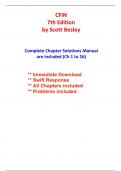CFIN
7th Edition
by Scott Besley
Complete Chapter Solutions Manual
are included (Ch 1 to 16)
** Immediate Download
** Swift Response
** All Chapters included
** Problems included
, Chapter 1 Solutions
1-1 Finance deals with decisions about money. Finance decisions deal with how money is
raised and used by businesses, governments, and individuals. In business, decisions
about cash inflows include for what price products should be sold, how funds should be
raised when firms have good investment opportunities, and so forth; decisions about
cash outflows include what expenses must be incurred, which investments should be
purchased, and so forth.
1-2 Simply stated, everyone should have a basic understanding of finance because everyone
faces financial decisions daily, whether those decisions are as simple as determining how
much money to carry in one’s pocket or they require more sophisticated thought
processes, such as the purchase of a house or planning for retirement. Persons who make
business decisions must understand finance because their decisions generally include an
element of finance in the sense that the results of their decisions generally require some
type of funding to be operationalized.
1-3 The value of a firm can be measured by the market value of its stock. Thus, the firm
maximizes value/wealth by maximizing the value of its stock.
1-4 Value is measured as the present value of the cash flows that an investment is expected
to generate during its life. The three factors that determine value are (1) the amount of
the future cash flows, (2) the timing of the future cash flows, and (3) investors’ required
rate of return. If the amount of the cash flows increases, the cash flows are received
sooner, investors’ required rate of return decreases, or any combination of these events
occur, the value of an investment will increase.
1-5 Profit maximization abstracts from (1) the timing of profits and (2) the riskiness of
different operating plans. However, both factors are reflected in stock price
maximization. Profit maximization is a short-sighted goal because it doesn’t consider the
impact on future earnings or the firm’s future risk position. On the other hand, a firm’s
value is determined by the cash flows it is expected to generate in the future, as well as
the risk associated with those expected cash flows. Thus, profit maximization would not
, necessarily lead to stock price maximization. A firm could maximize its current profit but
go bankrupt in the near future by implementing “corner-cutting” measures that increase
profits. Such measures might include not replacing equipment when it is worn out,
decreasing the quality of the product that is manufactured and sold, reducing the number
of employees, and so forth.
1-6 Such factors as a compensation system that is based on management performance
(bonuses tied to profits, stock option plans) as well as the possibility of being removed
from office (voted out of office, an unfriendly tender offer by another firm) serve to keep
management’s focus on stockholders’ interests. If a firm is taken over, or acquired, by
another firm, generally top management is let go. To help ensure that they are not in this
position, management should take steps to ensure the firm is operated as efficiently as
possible. Efficient firms generally are priced correctly in the financial markets, thus are
not takeover targets.
1-7 The answer to this question depends on which action satisfies you more as the sole owner
of the business. But chances are you would be inclined to maximize your personal
satisfaction, which does not preclude you from maximizing the value of the business. No
agency problem exists in a proprietorship because there is only one owner, and he or she
is the person who makes the day-to-day business decisions.
1-8 Provided that the rate of return on assets exceeds the interest rate on debt, greater use of
debt will raise the expected rate of return on stockholders’ equity. Also, the interest on
debt is tax deductible, which provides a further advantage. However, (1) greater use of
debt will have a negative impact on the stockholders if the company’s return on assets
falls below the cost of debt, and (2) increased use of debt increases the chances of going
bankrupt. The effects of the use of debt, called “financial leverage,” are spelled out in
detail in Chapter 16.
1-9 Corporate governance refers to the “set of rules” that a firm follows when conducting
business. In general, corporate governance relates to how a firm is operated. Corporate
governance affects the manner in which a firm approaches its decision-making tasks,




